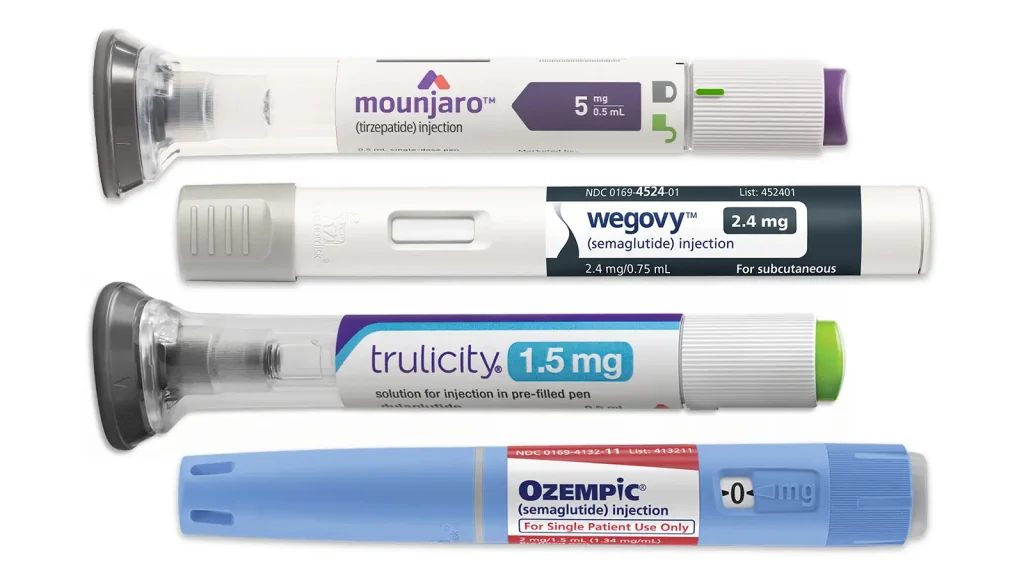GLP-1 Agonist Medications Patient Cost Overview

GLP-1 (Glucagon-Like Peptide-1) medications have proven very effective in the management of type 2 diabetes and obesity. However, the cost of these medications can be a concern for many patients and healthcare providers. Below is a detailed overview of the pricing for various GLP-1 medications, along with an exploration of the factors that contribute to their high costs. Additionally, we’ve provided a list of resources to help patients understand their insurance coverage and potential out-of-pocket costs for these treatments.
Out of Pocket Costs for GLP-1 Medications with no insurance coverage
- Wegovy (Semaglutide): Estimated Price Range $1350 – $1650
- Zepbound (Tirzepetide): Estimated Price Range $1050 – $1100
- Saxenda (Liraglutide): Estimated Price Range $1310 – $1500
- Ozempic (Semaglutide): Estimated Price Range $900 – $1000
- Mounjaro (Tirzepatide): Estimated Price Range $1050 – $1250
- Rybelsus (Semaglutide): Estimated Price Range $950 – $1100
- Trulicity (Dulaglutide): Estimated Price Range $850 – $1200
Factors that contribute to the high costs of GLP-1 medications
- Research and Development: Extensive and costly processes are required to bring new GLP-1 medications to market, including clinical trials and regulatory approvals.
- Patent Protection: Many GLP-1 medications are protected by patents, preventing the availability of less expensive generic versions and keeping prices high.
- Manufacturing Complexity: The production of GLP-1 medications involves complex biological processes, leading to higher manufacturing costs.
- Therapeutic Benefits: These medications offer significant benefits in treating type 2 diabetes and obesity, including blood sugar control, weight loss, and cardiovascular health, contributing to their value and cost.
- Market Demand: Rising prevalence of diabetes and obesity increases the demand for effective treatments, potentially driving up prices.
- Healthcare System Factors: The structure of healthcare systems, particularly in the United States, can influence drug pricing and reimbursement, affecting overall medication costs.
Patient Resources to check insurance coverage and out of pocket costs for weight loss medications
- Zepbound (Tirzepedide): Visit Zepbound Cost and Coverage to learn more about insurance coverage and savings programs for Zepbound.
- Wegovy (Semaglutide): Use the Wegovy Cost Navigator on NovoCare to check your insurance coverage and estimated costs for Wegovy.
- Saxenda (Liraglutide): Novo Nordisk’s NovoCare also covers Saxenda. For checking insurance coverage and costs, visit NovoCare for Saxenda.
- Ozempic (Semaglutide): Novo Nordisk’s NovoCare provides resources for checking insurance coverage for Ozempic. Visit NovoCare for Ozempic.
- Mounjaro (Tirzepatide): Visit Mounjaro Cost and Coverage on the official Mounjaro website by Eli Lilly for information on insurance coverage and savings programs.
- Rybelsus (Semaglutide): For insurance coverage information for Rybelsus, visit the Rybelsus Page on NovoCare.
- Trulicity (Dulaglutide): Check insurance coverage and savings options for Trulicity by visiting Trulicity Savings & Resources Page.
These resources offer tools and information to help patients understand insurance coverage and estimate costs associated with each GLP-1 medication.
As indicated by numerous manufacturers and corroborated by experience, with the correct prescription management and thorough engagement with insurance providers, most insured patients can access their medications at a monthly expense of no more than $30.
Challenges Associated with Compounded Medications
Due to the steep prices of conventional medications, there’s a notable demand for more affordable Compounded Medications. While these can offer a cost-effective solution when obtained from reliable sources, compounded medications come with their own set of risks. These include the potential for counterfeit products, challenges in maintaining proper storage and transportation conditions, and the risk of being prescribed without sufficient medical oversight. Such factors significantly elevate the health risks to patients.
While state pharmacy boards enforce standards for the compounding, storage, and shipping of GLP-1 medications, the administration of the potent GLP-1 medications necessitates vigilant clinical oversight. This approach ensures that patients receive personalized care tailored to their specific needs, minimizing risks and optimizing treatment outcomes. Getting these medication without close clinical supervision i.e. chat based prescriptions is dangerous.
Learn more about how the weight loss medications work, their benefits, and side effects.
Conclusion:
Navigating the complexities of medication prescriptions and insurance approvals can be daunting for patients. At Aayu Well, we are committed to making this process as smooth and efficient as possible. Our team of expert doctors carefully selects medications with a high likelihood of insurance approval, minimizing the burden on you. Furthermore, our dedicated support staff proactively works to secure the necessary prior-authorizations, ensuring you receive your medications without unnecessary delays or high out-of-pocket costs. It’s important to note that, in our pursuit of the highest standards of care and safety, we currently prioritize FDA- approved medications while still providing the option to get compounded medications to improve access. Trust in Aayu Well to prioritize your health and safety through every step of your treatment journey.
Live Well, Age Well with Aayu Well.
Have more questions?
Schedule a complimentary telemedicine visit with a board-certified medical doctor. During your visit, you will receive a comprehensive medical evaluation, an assessment of your suitability for weight loss treatment, verification of your insurance coverage for the medication, and personalized answers to all your questions. Schedule your appointment today!
– No Credit Card Required. Sign up only if you see value.




